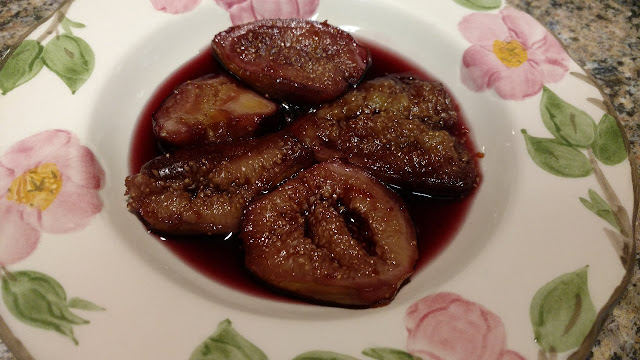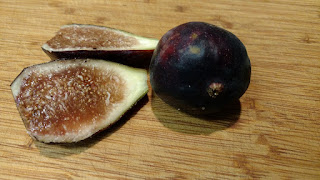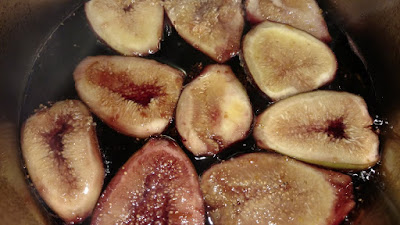
Recipe: Poached figs in wine and herbs

|
Summer figs, to me, are the epitome of California fruit. They love our climate. They have so much history. They’re easy to grow -- plus delicate, generous and delicious.
So much wrapped into one weird little package.
I grew up with backyard Mission fig trees. My grandmother made incredible amounts of fig jam, ready to fill cookies or top toast. The biggest treat was eating the figs fresh off the tree.

|
How do you tell if a fig is ripe? Tap it gently three times, my grandmother instructed. If it falls off in your hand, it’s ready.
There were times when I tapped those figs like little punching bags, and they still didn’t come off. (That became a lesson in patience.)
I still love picking (and eating) fresh figs. Besides straight off the tree, figs are a versatile and flavorful fruit, at home in desserts or salads as well as alongside meat or poultry.
Poached figs are a grown-up treat. As a dessert, poached figs can be topped with ice cream, whipped cream or by themselves. Or they can be served warm with the main course, especially when flavored with thyme or other savory herbs.
Figs poach quickly, so keep an eye on them. They can go from perfect to mushy in minutes.
Match wine with the fig variety: White wine with light-colored figs; and reds with dark figs. Also, experiment with the herb-citrus combinations.
For these Mission figs, I used Malbec with orange zest and lemon verbena. (The uncooked figs went well with the wine, too.)
Poached figs in wine with herbs
Makes 2 servings
Ingredients:
1 cup wine (your choice)
½ cup sugar
1 teaspoon citrus zest (lemon, orange, grapefruit or lime)
1 teaspoon fresh herbs (lemon verbena, thyme, rosemary, lavender, etc.)
5 to 6 figs, trimmed and halved (peeling optional)
Instructions:
In a medium saucepan, combine wine, sugar, zest and herbs. Bring to a boil.
Reduce heat to simmer. Cook for 5 minutes.
Add figs and cover. Poach for 5 minutes or until figs are tender, easily pierced with a sharp knife.
Remove figs with a slotted spoon. Strain poaching liquid, if desired, to make a wine sauce.
Serve warm or room temperature, with or without wine sauce.
 |
| Figs crowd the saucepan while floating in the poaching liquid. |
Comments
0 comments have been posted.Sacramento Digs Gardening to your inbox.
Food in My Back Yard Series
May 6: Maintain soil moisture with mulch for garden success
April 29: What's (already) wrong with my tomato plants?
April 22: Should you stock up on fertilizer? (Yes!)
April 15: Grow culinary herbs in containers
April 8: When to plant summer vegetables
April 1: Don't be fooled by these garden myths
March 25: Fertilizer tips: How to 'feed' your vegetables for healthy growth
March 18: Time to give vegetable seedlings some more space
March 11: Ways to win the fight against weeds
March 4: Potatoes from the garden
Feb. 25: Plant a fruit tree now -- for later
Feb. 18: How to squeeze more food into less space
Feb. 11: When to plant? Consider staggering your transplants
Feb. 4: Starting in seed starting
Sites We Like
Garden Checklist for week of May 11
Make the most of the lower temperatures early in the week. We’ll be back in the 80s by Thursday.
* Plant, plant, plant! It’s prime planting season in the Sacramento area. Time to set out those tomato transplants along with peppers and eggplants. Pinch off any flowers on new transplants to make them concentrate on establishing roots instead of setting premature fruit.
* Direct-seed melons, cucumbers, summer squash, corn, radishes, pumpkins and annual herbs such as basil.
* Harvest cabbage, lettuce, peas and green onions.
* In the flower garden, direct-seed sunflowers, cosmos, salvia, zinnias, marigolds, celosia and asters. (You also can transplant seedlings for many of the same flowers.)
* Plant dahlia tubers.
* Transplant petunias, marigolds and perennial flowers such as astilbe, columbine, coneflowers, coreopsis, dahlias, rudbeckia and verbena.
* Keep an eye out for slugs, snails, earwigs and aphids that want to dine on tender new growth.
* Feed summer bloomers with a balanced fertilizer.
* For continued bloom, cut off spent flowers on roses as well as other flowering plants.
* Add mulch to the garden to maintain moisture. Mulch also cuts down on weeds. But don’t let it mound around the stems or trunks of trees or shrubs. Leave about a 6-inch-to-1-foot circle to avoid crown rot or other problems.
* Remember to weed! Pull those nasties before they set seed.
* Water early in the day and keep seedlings evenly moist.